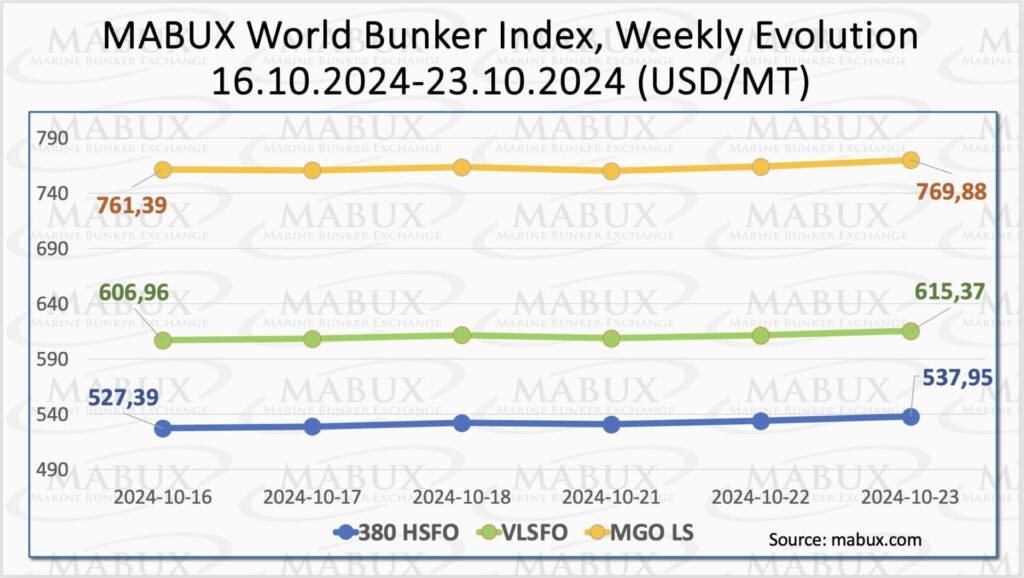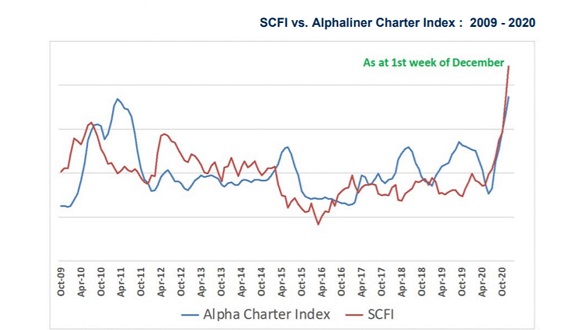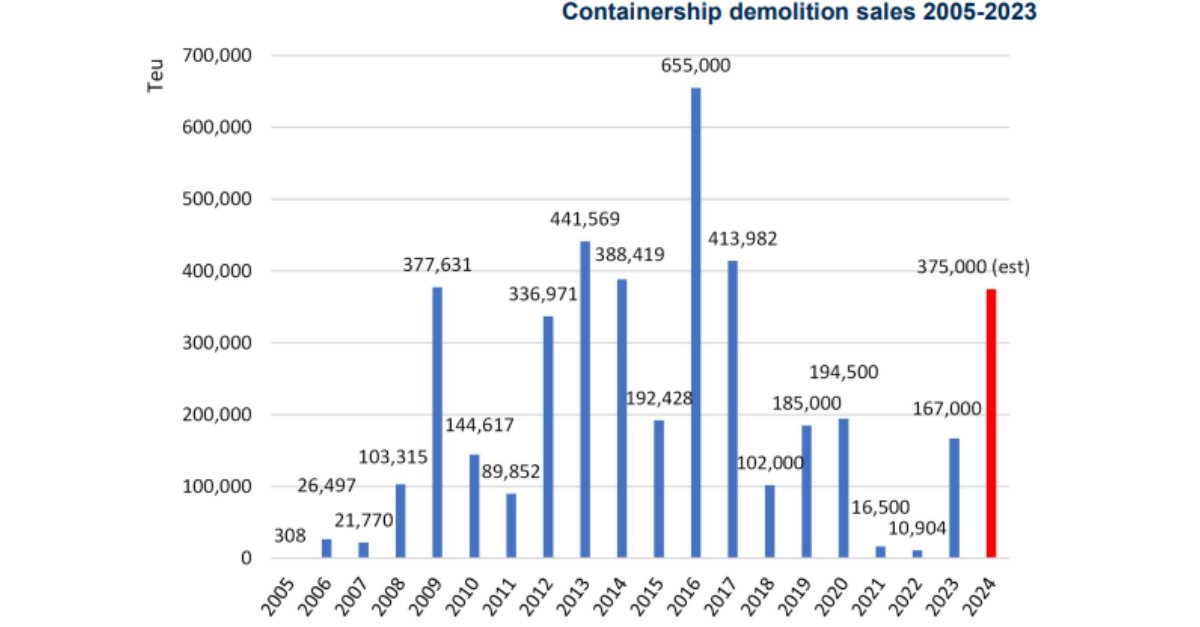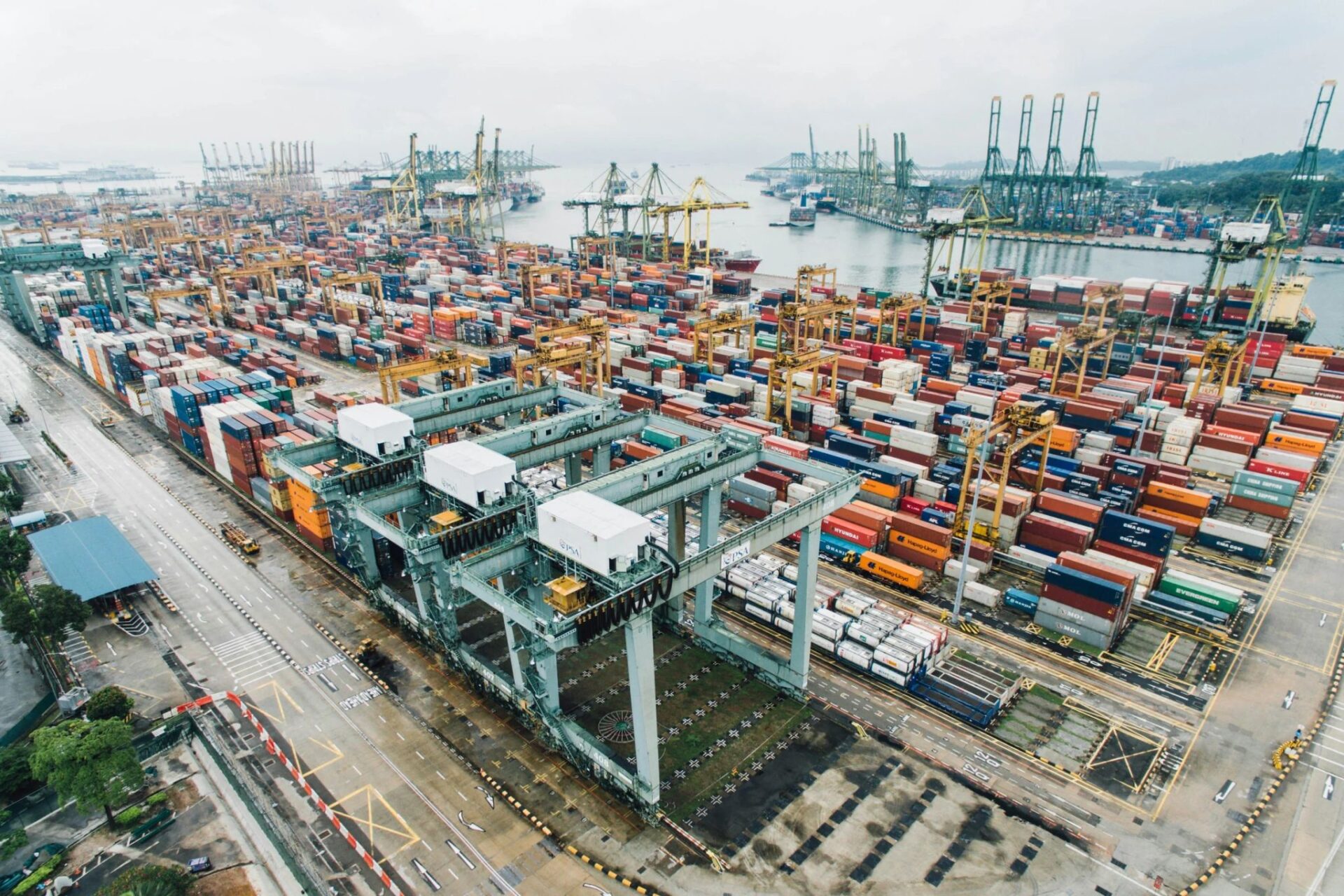

During Week 43, the MABUX global bunker indices showed a sustained upward trend. The 380 HSFO index rose by 10.56 USD: from 527.39 USD/MT last week to 537.95 USD/MT. The VLSFO index increased by 8.41 USD (615.37 USD/MT versus 606.96 USD/MT last week).
The MGO index added 8.49 USD (from 761.39 USD/MT last week to 769.88 USD/MT). At the time of writing, the global bunker indices entered again a moderate downward correction.
 MABUX Global Scrubber Spread (SS) – the price difference between 380 HSFO and VLSFO – continued to decline, falling by another $2.15 (from $79.57 last week to $77.42), remaining steadily below the $100.00 SS Breakeven mark.
MABUX Global Scrubber Spread (SS) – the price difference between 380 HSFO and VLSFO – continued to decline, falling by another $2.15 (from $79.57 last week to $77.42), remaining steadily below the $100.00 SS Breakeven mark.
The weekly average also dropped by $4.30. In Rotterdam, the SS Spread showed moderate growth: plus $6.00 ($58.00 vs. $52.00 last week), with the weekly average increasing by $18.83. In Singapore, the difference in price 380 HSFO/VLSFO narrowed by $11.00: from $117.00 last week to $106.00, approaching the $100.00 mark. The weekly average in Singapore dropped by $1.84.
Thus, SS Spread values continue to stay stably below the $100 mark or approaching it. Overall, SS Spread values remain stably below or near the $100 mark, with a continued narrowing expected next week. More detailed data is available in the “Differentials” section of mabux.com.
 European gas prices have been rising modestly in recent weeks due to supply concerns, exacerbated by heightened tensions in the Middle East following Iran’s missile strikes on Israel in early October. These developments have caused high gas prices in Europe, leading to a diversion of several LNG cargoes from Asia to Europe. As of October 22,
European gas prices have been rising modestly in recent weeks due to supply concerns, exacerbated by heightened tensions in the Middle East following Iran’s missile strikes on Israel in early October. These developments have caused high gas prices in Europe, leading to a diversion of several LNG cargoes from Asia to Europe. As of October 22,
European regional storage facilities were 95.32% full, although this will not be sufficient to fully cover winter demand. Current storage levels are slightly below last year’s, largely due to fewer incoming LNG cargoes. While the rerouting of LNG cargoes to Europe may alleviate some supply concerns, prices are still expected to rise due to seasonal demand and increased competition between Europe and Asia for LNG.
By the end of Week 43, the European gas benchmark TTF saw moderate growth: plus 0.731 EUR/MWh (40.704 EUR/MWh versus 39.973 EUR/MWh last week).
 The price of LNG as a bunker fuel in the port of Sines (Portugal) decreased by 10 USD by the end of the week, reaching 867 USD/MT on October 21. Meanwhile, the price difference between LNG and conventional fuel on October 21 widened significantly: on October 21, the difference was 154 USD in favor of MGO LS, up from 123 USD the previous week.
The price of LNG as a bunker fuel in the port of Sines (Portugal) decreased by 10 USD by the end of the week, reaching 867 USD/MT on October 21. Meanwhile, the price difference between LNG and conventional fuel on October 21 widened significantly: on October 21, the difference was 154 USD in favor of MGO LS, up from 123 USD the previous week.
On this day, MGO LS was quoted at 713 USD/MT in the port of Sines. For more detailed information, refer to the LNG Bunkering section on mabux.com.
 During Week 43, the MDI index (the correlation ratio of market bunker prices (MABUX MBP Index) vs. MABUX digital bunker benchmark (MABUX DBP Index)) registered the following trends across the four largest global hubs: Rotterdam, Singapore, Fujairah and Houston:
During Week 43, the MDI index (the correlation ratio of market bunker prices (MABUX MBP Index) vs. MABUX digital bunker benchmark (MABUX DBP Index)) registered the following trends across the four largest global hubs: Rotterdam, Singapore, Fujairah and Houston:
 Over the week, the balance of overvalued/undervalued ports had completely moved into the undervalued zone. The trend towards undervaluation of all types of bunker fuel remains dominant in the global bunker market.
Over the week, the balance of overvalued/undervalued ports had completely moved into the undervalued zone. The trend towards undervaluation of all types of bunker fuel remains dominant in the global bunker market.
By the end of the week, the balance of overvalued/undervalued ports remained largely unchanged. However, the trend towards undervaluation of all types of bunker fuel continues to dominate the global bunker market.
For more insights into the correlation between market prices and the MABUX digital benchmark, visit the “Digital Bunker Prices” section at mabux.com.
The implementation of the Mediterranean Sea 0.10% Sulphur Emission Control Area (MedECA) in May next year is expected to cause an “inevitable” decline in demand for 0.50% very low sulphur fuel oil (VLSFO) in the region, according to shipbroker Gibson.
In its latest report, the broker noted that while similar 0.10% Sulphur Emission Control Areas in the US, the Baltics, and Northern Europe, as well as the global 0.50% sulphur cap (IMO 2020), have demonstrated that refineries and bunker fuel suppliers can adapt relatively quickly to changes in demand, these shifts will nonetheless affect bunker fuel prices and commodity flows into and out of the region.
Gibson estimates current bunker fuel demand in the Mediterranean at 21.5 million tonnes, with over 50% of this being 0.50% VLSFO. Once the MedECA regulations take effect, VLSFO demand could drop by as much as 6 million tonnes annually as ships transition to marine gas oil (MGO) and ultra-low sulphur fuel oil (ULSFO), both containing 0.1% sulphur.
The report also highlights that demand for high sulphur fuel oil (HSFO) should remain stable since vessels equipped with scrubbers will continue to operate using it. However, as not all scrubber systems are capable of cleaning HSFO to meet the 0.1% sulphur threshold, it remains uncertain how many shipowners will need to switch to alternative fuel types.
The decrease in VLSFO demand is also likely to lead to an increase in exports from the region, particularly towards areas east of Suez. Concurrently, the Mediterranean is expected to face a growing gasoil shortage, prompting increased imports from the US and the Middle East.
Overall, we expect the global bunker market to maintain the potential for moderate growth next week.
Source: MABUX













